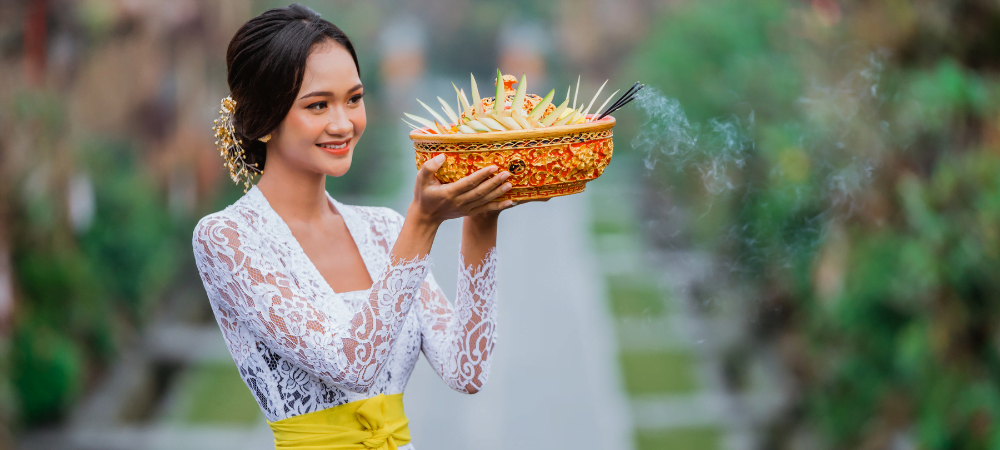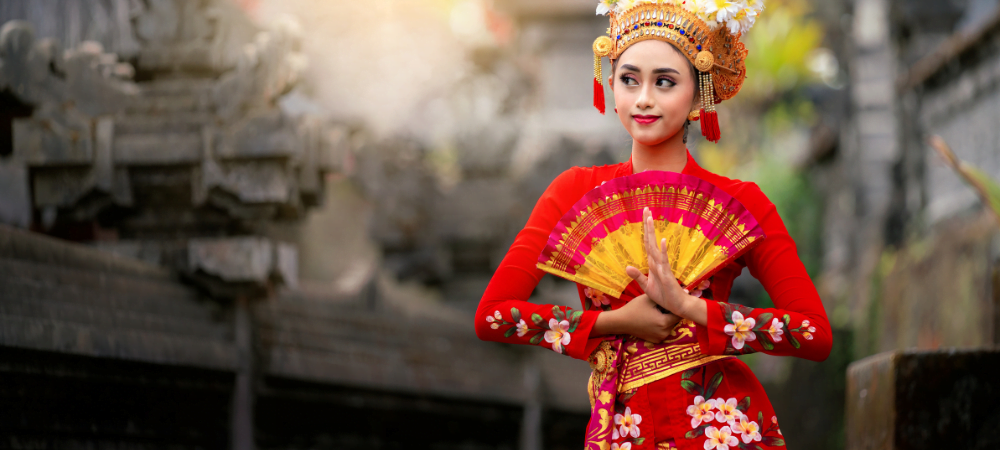Bali Unveiled: Daily Customs and Traditions
Nestled amidst the vast Indonesian archipelago, Bali stands out not just for its breathtaking landscapes but also for its deeply rooted customs and traditions. Often referred to as the “Island of the Gods,” Bali is a melting pot of culture, spirituality, and age-old traditions that have been passed down through generations.
Also read: Why Seminyak is the best place to visit in Bali
As tourists flock to its pristine beaches and lush terrains, there’s an underlying tapestry of rituals, ceremonies, and daily practices that truly define the essence of Bali. This article aims to unveil the rich cultural tapestry of Bali, offering readers an intimate glimpse into the heart and soul of this enchanting island.
Whether you’re a curious traveller or someone with a penchant for culture, join us as we journey through the myriad customs and traditions that make Bali truly unique. (1)
Religious Practices
Bali, unlike the majority of Indonesia, is predominantly Hindu, but it’s not the same Hinduism practiced in countries like India or Nepal. Instead, Balinese Hinduism is a blend of local animism, ancestor worship, and the more familiar elements of the Indian Hindu religion. This unique fusion gives birth to practices and rituals that are distinctly Balinese.
The Predominance of Balinese Hinduism
Balinese Hinduism is deeply interwoven into the fabric of daily life. Everywhere you go, from bustling towns to remote villages, the influence of this religion is palpable. Intricately carved temples, statues of deities, and colorful religious processions are common sights, reflecting the island’s deep spiritual roots.
Temple Ceremonies and Rituals
Temples, known locally as ‘Pura’, are more than just places of worship in Bali. They are centers of community life and play a pivotal role in the island’s cultural and spiritual landscape. Each temple has its own festival, known as ‘Odalan’, which is celebrated every 210 days according to the Balinese calendar. During these festivals, the temple is adorned with vibrant decorations, and the air is filled with the scent of incense and the rhythmic beats of gamelan music. Locals gather in their finest traditional attire, offering prayers, performing dances, and participating in processions.
Importance of the Pura in Daily Life
There are thousands of temples scattered across Bali, each with its own significance. The most important ones are the ‘Nine Directional Temples’ (Kahyangan Jagat), which are strategically located around the island to protect its inhabitants from evil spirits. But beyond these major temples, every village has at least three temples, and every home has its own shrine. These places of worship act as a constant reminder of the Balinese philosophy of maintaining a balance between the spiritual and physical worlds.
In Bali, religion is not just a set of beliefs or rituals; it’s a way of life. The island’s religious practices are a testament to the Balinese people’s unwavering faith and their deep connection to the spiritual realm. Whether you’re witnessing a grand temple ceremony or a simple daily offering placed at a home’s entrance, the spiritual energy of Bali is undeniable and truly captivating.
Traditional Dress
The vibrant and intricate traditional attire of the Balinese is not just a feast for the eyes, but also a reflection of the island’s rich cultural heritage. Dressing appropriately, especially during religious ceremonies and temple visits, is of paramount importance, showcasing respect and understanding of Balinese customs.
Sarongs and Sashes
A sarong, locally known as ‘kain’, is a piece of cloth wrapped around the lower body, akin to a long skirt. Both men and women wear sarongs, especially during religious ceremonies. The sash, or ‘selendang’, is tied around the waist over the sarong, symbolizing the separation of the lower human desires from the upper spiritual aspirations.
Proper Attire for Temple Visits
Visitors to Balinese temples are expected to dress modestly. For men, this typically means a sarong, a sash, and a shirt. Women should also wear a sarong and sash, accompanied by a blouse that covers the shoulders and upper arms. Many temples offer rental sarongs and sashes for tourists who arrive unprepared, but wearing your own is a gesture of respect.
Traditional Clothing during Ceremonies and Festivals
During special ceremonies, the Balinese don more elaborate versions of their traditional attire. Men might wear a ‘udeng’ or headcloth, symbolizing the mind’s control over the body. Women often wear ‘kebaya’, a traditional blouse-dress, paired with a beautifully patterned sarong. The colors, patterns, and accessories often have specific meanings and vary based on the nature of the ceremony.
Accessories and Adornments
Jewelry plays a significant role in Balinese traditional dress. Silver and gold bangles, earrings, and necklaces are commonly worn by women. The designs often incorporate symbols from nature and Hindu mythology. Men might wear ‘gelang kana’, a type of wristband, and ‘kris’, a ceremonial dagger, tucked into the back of their sash.
In Bali, clothing is not just about aesthetics; it’s a reflection of one’s respect for tradition, spirituality, and the community. The intricate designs, patterns, and accessories tell stories of the island’s past, its beliefs, and its aspirations for the future. As a visitor, donning traditional Balinese attire is not just an immersive cultural experience but also a step towards understanding and respecting the island’s deep-rooted customs.
Daily Offerings (Canang Sari)
One of the most ubiquitous sights in Bali is the presence of small, colorful offerings known as “Canang Sari.” These handcrafted offerings, often placed at homes, temples, shops, and even on sidewalks, are a testament to the Balinese dedication to maintaining harmony and balance in their daily lives.
Meaning and Significance of Daily Offerings
“Canang” refers to the tray made from palm leaves, while “Sari” denotes the essence of the offering, which can be flowers, food, or money. Together, Canang Sari represents the gratitude of the Balinese people to the supreme god, Sang Hyang Widhi Wasa. It’s a daily gesture of thanks for the peace and prosperity bestowed upon the world.
The Art of Crafting Canang Sari
Creating Canang Sari is a meticulous process, often taught from one generation to the next. The base tray is crafted from palm leaves, cut and woven into a square or round shape. Atop this base, items like betel leaves, lime, tobacco, and areca nuts are placed, symbolizing the three major Hindu deities: Brahma, Vishnu, and Shiva. This is then adorned with flowers placed in specific directions, each color representing a god. For instance, white flowers pointing eastward symbolize Iswara, while red flowers pointing south represent Brahma.
Where and When They Are Placed
Every morning, after preparing and praying, Balinese women place Canang Sari at various points around their homes, temples, and businesses. It’s common to find them on the ground in front of shops, on shrines, and even on the dashboards of cars and scooters. They are also placed at intersections, bridges, and riverbanks – essentially, any place where the Balinese feel the need for protection and blessings.
The Cycle of Nature
One of the beautiful aspects of Canang Sari is its impermanence. As they are made from organic materials, they degrade naturally, symbolizing the cycle of life and death. While they may be swept away or replaced the next day, the essence of the offering remains, perpetuating the cycle of gratitude and reverence.
The daily ritual of Canang Sari is a profound reflection of Bali’s spiritual ethos. It’s a reminder of the island’s deep connection to the divine, the importance of gratitude, and the ever-present pursuit of balance and harmony in daily life. For visitors, these small, fragrant offerings are not just a cultural insight but also an invitation to pause, reflect, and appreciate the world’s blessings.
FAQ
What are the common greetings and expressions used in daily communication in Bali?
In Bali, greetings and expressions are often influenced by the Balinese language, although Indonesian is widely spoken too. Some common greetings include “Om Swastiastu” (a respectful greeting and farewell), “Selamat pagi” (good morning), “Selamat siang” (good afternoon), and “Selamat malam” (good evening). When thanking someone, you can say “Terima kasih” and to apologize or get someone’s attention, “Maaf” is used. Understanding and using these basic phrases can help visitors navigate daily interactions and show respect towards the local culture and language while in Bali.
How do the phases of the moon impact daily life and religious practices in Bali?
The phases of the moon have significant influence on daily life and religious practices in Bali. Balinese Hinduism closely ties spiritual activities to the lunar calendar. Each phase of the moon is associated with specific ceremonies and rituals. For instance, the full moon (Purnama) and new moon (Tilem) are considered particularly auspicious and are often marked with temple ceremonies, family gatherings, and offerings to deities. Furthermore, some Balinese traditional ceremonies, like Odalan (temple festivals), are determined based on the lunar cycle. Consequently, the moon’s phases aren’t merely celestial phenomena in Bali but are intrinsically woven into the cultural and spiritual tapestry of the island.
What is the importance of rice cultivation, and how is it interwoven with daily customs?
Rice cultivation is deeply intertwined with daily life and customs in Bali. It is not only a crucial component of the island’s economy and diet but also holds significant spiritual and cultural importance. The Subak system, a cooperative water management system of canals and weirs, is employed in Balinese rice farming and is also linked to temple rituals. Rice is seen as a gift from the gods, and Dewi Sri, the rice goddess, is highly revered. Various ceremonies, like the rice harvest festival, are dedicated to honoring these deities. Rituals, offerings, and festivals are embedded in the agricultural calendar, illustrating how rice cultivation is interwoven with spiritual practices and community life in Bali.
- Welcome Back To My Villas in Bali - November 17, 2021





